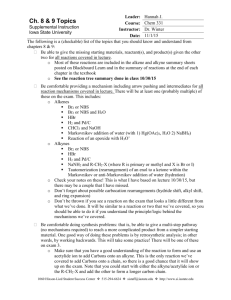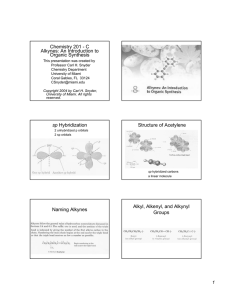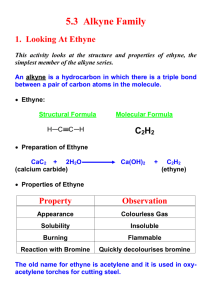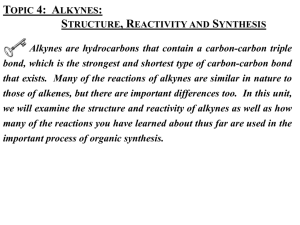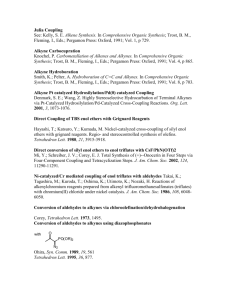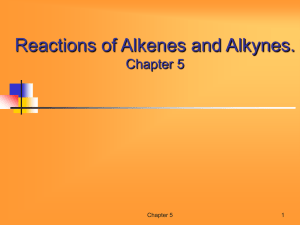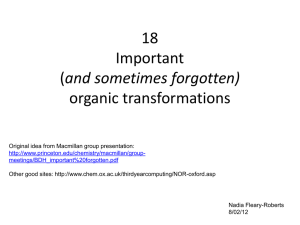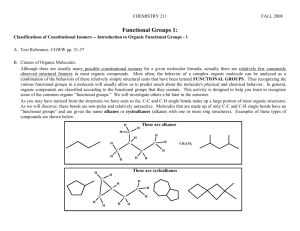Ch 9 Alkynes
advertisement
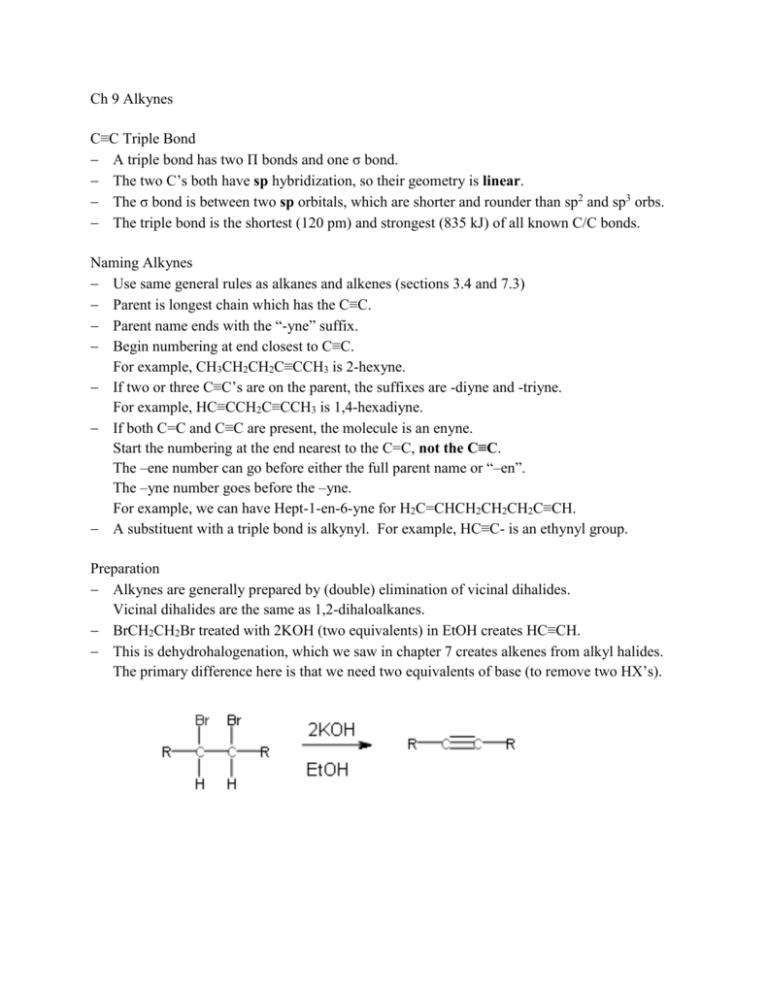
Ch 9 Alkynes C≡C Triple Bond A triple bond has two Π bonds and one σ bond. The two C’s both have sp hybridization, so their geometry is linear. The σ bond is between two sp orbitals, which are shorter and rounder than sp2 and sp3 orbs. The triple bond is the shortest (120 pm) and strongest (835 kJ) of all known C/C bonds. Naming Alkynes Use same general rules as alkanes and alkenes (sections 3.4 and 7.3) Parent is longest chain which has the C≡C. Parent name ends with the “-yne” suffix. Begin numbering at end closest to C≡C. For example, CH3CH2CH2C≡CCH3 is 2-hexyne. If two or three C≡C’s are on the parent, the suffixes are -diyne and -triyne. For example, HC≡CCH2C≡CCH3 is 1,4-hexadiyne. If both C=C and C≡C are present, the molecule is an enyne. Start the numbering at the end nearest to the C=C, not the C≡C. The –ene number can go before either the full parent name or “–en”. The –yne number goes before the –yne. For example, we can have Hept-1-en-6-yne for H2C=CHCH2CH2CH2C≡CH. A substituent with a triple bond is alkynyl. For example, HC≡C- is an ethynyl group. Preparation Alkynes are generally prepared by (double) elimination of vicinal dihalides. Vicinal dihalides are the same as 1,2-dihaloalkanes. BrCH2CH2Br treated with 2KOH (two equivalents) in EtOH creates HC≡CH. This is dehydrohalogenation, which we saw in chapter 7 creates alkenes from alkyl halides. The primary difference here is that we need two equivalents of base (to remove two HX’s). Addition of HX and X2 Similar to alkene addition reactions, but not identical. With HX addition, the reaction follows Markovnikov’s rule, so that the H+1 adds to the less substituted C preferentially. This creates a 2o vinylic cation as the intermediate. The 1o vinylic cation is so unstable that it essentially does not exist! Two equivalents of HX can be added to an alkyne to make a dihaloalkane. For this reaction, X can be Cl, Br, or I. Note that both of the halogens have added to the more substituted C. The halogens are never added to a terminal C. Addition of the first Br2 or Cl2 equivalent puts one halogen on each of the two C’s. The resulting stereochemistry is always trans. Also, two equivalents of X2 can be added to the alkyne to make a tetrahaloalkane. So that two halogens will add to each C. 2nd equivalent of Br2 Br2 (E) dibromoalkene tetrabromoalkane . Hydration with Hg(II) Water is added to the alkyne triple bond with aqueous HgSO4 and H2SO4. With a terminal alkyne (RC≡CH), an OH is added to the more substituted C. This is Markovnikov orientation, as is the case with oxymercuration of alkenes. The C’s still have a double bond after the OH addition, which creates an enol (H2C=COHR). The enol quickly rearranges to a methyl ketone (H3CC=OR). This called the keto-enol tautomerization, where tautomers are constitutional isomers which interconvert rapidly. In this case, the two tautomers are the enol and the ketone. An unsymmetrical internal alkyne (R’C≡CR) will result in a mixture of two ketones. (R’C=OCH2R and R’CH2C=OR) In contrast to oxymercuration of alkenes, NaBH4 is not needed to obtain the product. The acid alone is sufficient to remove the Hg. The mechanism is shown as Figure 9.3 in McMurry. Hydration with Borane (Hydroboration/Oxidation) Treating an internal alkyne (RC≡CR) with BH3 in THF will add BH2 to one C and add H to the other C. This creates a vinylic borane (RHC=CBH2R). The vinylic borane will be Z, with both alkyls on the same side. The vinylic borane is then treated with H2O2 and NaOH(aq) at pH 8. This creates an enol (RHC=COHR), which rearranges to a ketone (RCH2C=OR). Overall, the reaction scheme is as follows: Using BH3 with a terminal alkene (RC≡CH) would simply not work! The terminal alkene is more reactive and adds a BH3 across both bonds. The B will add to three alkyne molecules, which then add to more BH3, and then more alkynes are added, eventually making... For terminal alkynes, use R2BH instead. A bulky alkyl group (R) will prevent a reaction with the second Π bond. R is typically a cyclohexyl or sec-isoamyl group. The –BR2 unit adds to the terminal C to create R’CHCH(BR2). H2O2 at pH 8 is then added, but the result is an aldehyde (RCH2CHO) rather than a ketone. R2BH H2O2 THF OH-(aq) pH = 8 terminal alkyne organoborane aldehyde Reduction of Alkynes As with alkenes, reduction with H2 using Pd/C or PtO2 as a catalyst will create an alkane. An alkyne can be converted to a cis-alkene using the Lindlar catalyst, which is deactivated Pd on CaCO3 support. An alkyne can be converted to a trans-alkene using the Li metal and NH3. The reaction is performed at -33 oC, which is the normal BP of NH3. Oxidative Cleavage Either KMnO4 or O3 can be used, but the results are slightly different than for alkenes. Using either reagent with an internal alkyne (RC≡CR) will create two carboxylic acids. RC≡CR (with either KMnO4 or O3) 2RCOOH Using either reagent with a terminal alkyne (RC≡CH) will create one equivalent of carboxylic acid and one equivalent of O=C=O. RC≡CH (with either KMnO4 or O3) RCOOH + CO2 These reactions have little use in synthesis, but have been commonly used to determine alkyne structures. Alkyne Acidity Terminal alkynes can be used to create acetylide anions (RC≡C−1). The shorter sp orbital on the terminal C can stabilize a negative charge, because the negative charge is closer to the positive carbon nucleus. So, the pKa of the terminal alkyne is ~25, which is much lower than the pKa of alkyl and alkenyl H’s (~44 and ~60, respectively). This is not strongly acidic, but a terminal H can be removed from the alkyne with a very strong base, if its conjugate acid has pKa > 25. So, RC≡CH will react with NaNH2 (sodium amide), because NH3 has pKa = 35. RC≡CH + NaNH2 (in NH3) RC≡C−1Na+1 + NH3 Alkylation of Acetylide Anions The acetylide anion can replace a halide of a 1o alkyl halide (RCH2Br). The halide needs to be 1o, because 2o and 3o will undergo eliminations instead. RC≡C−1Na+1 + BrCH2R’ RC≡CCH2R’ + Na+1 + Br−1 The result is a longer internal alkyne, rather than the another terminal alkyne. The full scheme can be seen in this example: CH3C≡CH + NH2−1 (in NH3) CH3C≡C−1 + NH3 CH3C≡C−1 + BrCH2CH3 CH3C≡CCH2CH3 + Br−1

